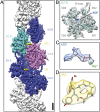Near-atomic structure of jasplakinolide-stabilized malaria parasite F-actin reveals the structural basis of filament instability
- PMID: 28923924
- PMCID: PMC5635891
- DOI: 10.1073/pnas.1707506114
Near-atomic structure of jasplakinolide-stabilized malaria parasite F-actin reveals the structural basis of filament instability
Abstract
During their life cycle, apicomplexan parasites, such as the malaria parasite Plasmodium falciparum, use actomyosin-driven gliding motility to move and invade host cells. For this process, actin filament length and stability are temporally and spatially controlled. In contrast to canonical actin, P. falciparum actin 1 (PfAct1) does not readily polymerize into long, stable filaments. The structural basis of filament instability, which plays a pivotal role in host cell invasion, and thus infectivity, is poorly understood, largely because high-resolution structures of PfAct1 filaments were missing. Here, we report the near-atomic structure of jasplakinolide (JAS)-stabilized PfAct1 filaments determined by electron cryomicroscopy. The general filament architecture is similar to that of mammalian F-actin. The high resolution of the structure allowed us to identify small but important differences at inter- and intrastrand contact sites, explaining the inherent instability of apicomplexan actin filaments. JAS binds at regular intervals inside the filament to three adjacent actin subunits, reinforcing filament stability by hydrophobic interactions. Our study reveals the high-resolution structure of a small molecule bound to F-actin, highlighting the potential of electron cryomicroscopy for structure-based drug design. Furthermore, our work serves as a strong foundation for understanding the structural design and evolution of actin filaments and their function in motility and host cell invasion of apicomplexan parasites.
Keywords: F-actin; Plasmodium; cryo-EM; jasplakinolide; malaria.
Conflict of interest statement
The authors declare no conflict of interest.
Figures

















Similar articles
-
Malaria parasite actin polymerization and filament structure.J Biol Chem. 2010 Nov 19;285(47):36577-85. doi: 10.1074/jbc.M110.142638. Epub 2010 Sep 7. J Biol Chem. 2010. PMID: 20826799 Free PMC article.
-
Evolutionarily divergent, unstable filamentous actin is essential for gliding motility in apicomplexan parasites.PLoS Pathog. 2011 Oct;7(10):e1002280. doi: 10.1371/journal.ppat.1002280. Epub 2011 Oct 6. PLoS Pathog. 2011. PMID: 21998582 Free PMC article.
-
Unusual dynamics of the divergent malaria parasite PfAct1 actin filament.Proc Natl Acad Sci U S A. 2019 Oct 8;116(41):20418-20427. doi: 10.1073/pnas.1906600116. Epub 2019 Sep 23. Proc Natl Acad Sci U S A. 2019. PMID: 31548388 Free PMC article.
-
Holding back the microfilament--structural insights into actin and the actin-monomer-binding proteins of apicomplexan parasites.IUBMB Life. 2012 May;64(5):370-7. doi: 10.1002/iub.1014. Epub 2012 Mar 27. IUBMB Life. 2012. PMID: 22454107 Review.
-
Actin regulation in the malaria parasite.Eur J Cell Biol. 2011 Nov;90(11):966-71. doi: 10.1016/j.ejcb.2010.11.011. Epub 2011 Jan 21. Eur J Cell Biol. 2011. PMID: 21256619 Review.
Cited by
-
Differential requirements for cyclase-associated protein (CAP) in actin-dependent processes of Toxoplasma gondii.Elife. 2019 Oct 2;8:e50598. doi: 10.7554/eLife.50598. Elife. 2019. PMID: 31577230 Free PMC article.
-
Structural basis of rapid actin dynamics in the evolutionarily divergent Leishmania parasite.Nat Commun. 2022 Jun 15;13(1):3442. doi: 10.1038/s41467-022-31068-y. Nat Commun. 2022. PMID: 35705539 Free PMC article.
-
Cryo-EM Resolves Molecular Recognition Of An Optojasp Photoswitch Bound To Actin Filaments In Both Switch States.Angew Chem Int Ed Engl. 2021 Apr 12;60(16):8678-8682. doi: 10.1002/anie.202013193. Epub 2021 Mar 4. Angew Chem Int Ed Engl. 2021. PMID: 33449370 Free PMC article.
-
Cryo-EM Structure of Actin Filaments from Zea mays Pollen.Plant Cell. 2019 Dec;31(12):2855-2867. doi: 10.1105/tpc.18.00973. Epub 2019 Oct 18. Plant Cell. 2019. PMID: 31628168 Free PMC article.
-
Polymerization and depolymerization of actin with nucleotide states at filament ends.Biophys Rev. 2018 Dec;10(6):1513-1519. doi: 10.1007/s12551-018-0483-7. Epub 2018 Nov 20. Biophys Rev. 2018. PMID: 30460458 Free PMC article. Review.
References
-
- Straub FB. Actin. Stud Inst Med Chem Univ Szeged. 1942;II:3–15.
-
- Kabsch W, Mannherz HG, Suck D, Pai EF, Holmes KC. Atomic structure of the actin: DNase I complex. Nature. 1990;347:37–44. - PubMed
-
- Holmes KC, Popp D, Gebhard W, Kabsch W. Atomic model of the actin filament. Nature. 1990;347:44–49. - PubMed
-
- Fujii T, Iwane AH, Yanagida T, Namba K. Direct visualization of secondary structures of F-actin by electron cryomicroscopy. Nature. 2010;467:724–728. - PubMed
Publication types
MeSH terms
Substances
Associated data
- Actions
LinkOut - more resources
Full Text Sources
Other Literature Sources

